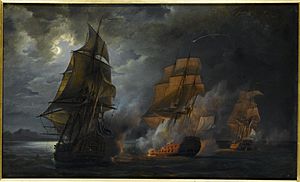HMS Jupiter (1778) facts for kids

Naval battle off the coast of Lisbon, 20 October 1778. The French ship Triton against the British ship Jupiter and the frigate Medea. Painting by Pierre-Julien Gilbert
|
|
Quick facts for kids History |
|
|---|---|
| Name | HMS Jupiter |
| Ordered | 21 June & 1 July 1776 |
| Builder | John Randall & Co, Rotherhithe |
| Laid down | July 1776 |
| Launched | 13 May 1778 |
| Completed | By 26 July 1778 |
| Fate | Wrecked on 10 December 1808 |
| General characteristics | |
| Class and type | 50-gun Portland-class fourth rate |
| Tons burthen | 1,061 30⁄94 (bm) |
| Length |
|
| Beam | 40 ft 10 in (12.4 m) |
| Depth of hold | 17 ft 6 in (5.3 m) |
| Propulsion | Sails |
| Sail plan | Full-rigged ship |
| Complement | 350 |
| Armament |
|
HMS Jupiter was a 50-gun warship of the Royal Navy. She was part of the Portland-class, known as a fourth rate ship. Jupiter served for thirty years during important conflicts like the American War of Independence, the French Revolutionary Wars, and the Napoleonic Wars. She was also one of the fastest ships in the Royal Navy at the time.
Contents
Building a Warship
Jupiter was built in Rotherhithe, England, and launched in 1778. She had a special new feature: her hull was covered in copper plates. This copper covering helped protect the ship's wooden hull from worms and barnacles. A clever new idea was used to protect the iron bolts holding the copper in place. Thick paper was placed between the copper plates and the hull. This stopped the iron and copper from reacting with each other, which could damage the ship. This new method worked very well for Jupiter.
Adventures at Sea
Jupiter had many exciting moments during her service.
Early Battles
On 20 October 1778, Jupiter and another British ship, Medea, fought a French warship called Triton. The battle was fierce but neither side won clearly. Jupiter had 3 sailors killed and 7 wounded.
Later, on 1 April 1779, Jupiter helped another British ship, Delight. Delight had just captured a French privateer (a privately owned warship) named Jean Bart.
On 2 October 1779, Jupiter captured two French ships, Mutin and Pilote. Both were small, fast ships with 14 guns each. They surrendered after a fight that left Mutin badly damaged. The Royal Navy decided to use both captured ships. Jupiter also took part in the Battle of Porto Praya in 1781.
Royal Transport and More Battles
In 1795, Jupiter had a special mission. She carried Caroline of Brunswick, who was soon to become a princess, from Germany to London. The journey took a week because of bad weather.
Later that year, Jupiter fought in the Battle of Muizenberg. This battle was important for capturing the Cape of Good Hope in South Africa. For her role, Jupiter earned a special honour called 'Cape of Good Hope'. In 1799, she fought a French frigate after another battle near Algoa Bay.
Jupiter also helped recapture several merchant ships that had been taken by the French. On 25 April 1799, she worked with Adamant and Tremendous to get back a ship called Chance. They also rescued another ship and helped save cargo from an American ship called Pacific.
Later Years and an Accident
In 1801, Jupiter sailed from Brazil to Cape Town, South Africa. She was escorting a group of East Indiamen (large merchant ships) that were heading to China.
On 27 February 1806, a fire broke out on Jupiter while she was in Port Royal, Jamaica. To put out the fire, the crew had to intentionally sink the ship. This is called scuttling. Luckily, she was later brought back to the surface, repaired, and put back into service.
In 1807, Jupiter sailed from Portsmouth, England, to escort more East Indiamen towards India and China.
The End of Jupiter
Jupiter was sadly wrecked on 10 December 1808 in Vigo Bay off the coast of Spain. Thankfully, all her crew members were saved.
Her captain, Henry Barker, was trying to anchor Jupiter close to Vigo Harbour at dusk. He wanted to enter the harbour early the next morning. But as the ship moved into position, she hit a hidden reef. The crew tried to make the ship lighter by throwing heavy items overboard, but it didn't work. The ship was taking on too much water. Over the next two days, they removed as many supplies as possible. Then, the ship fell onto its side and was left as a wreck. A naval court later told Captain Barker to be more careful in the future.

